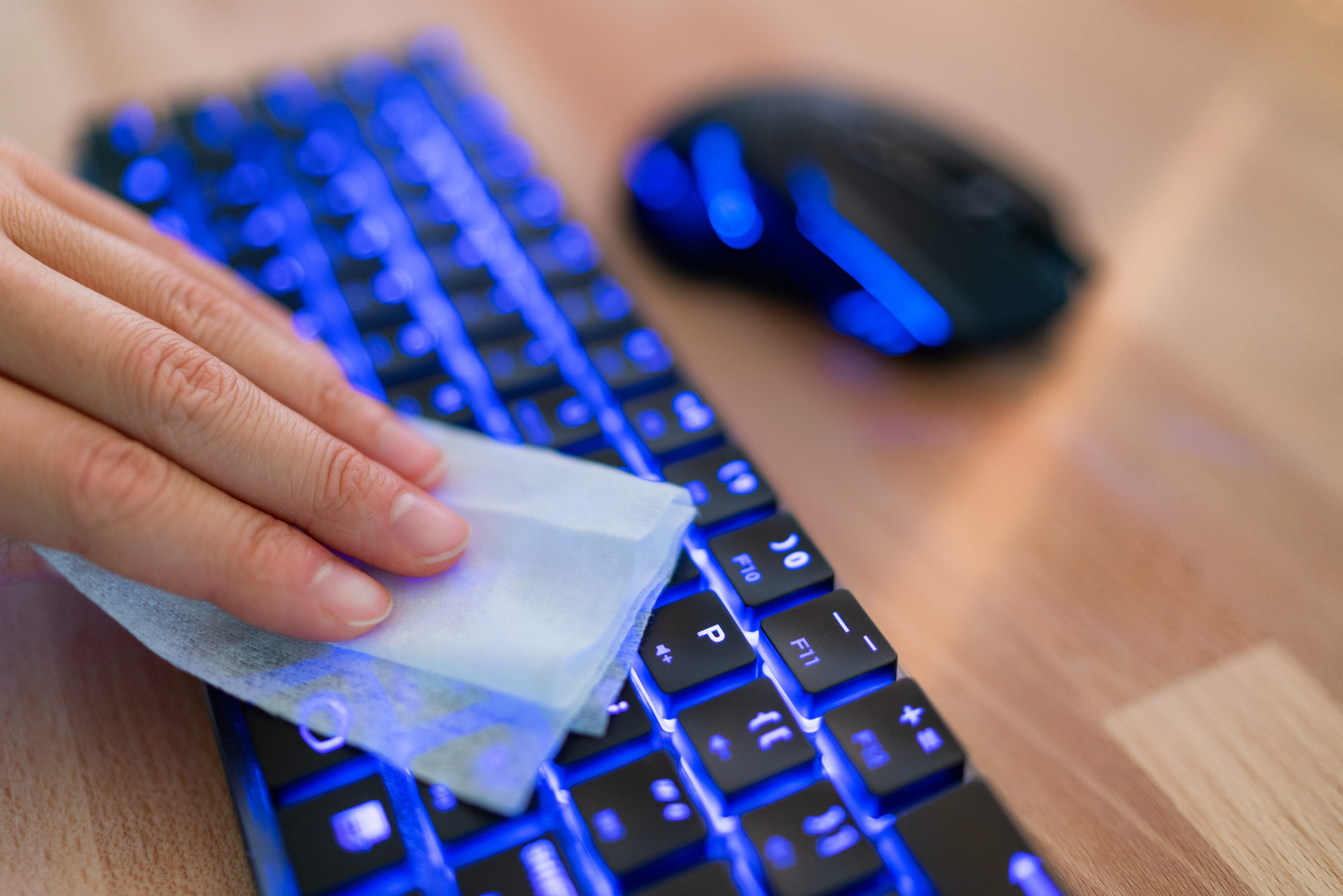
After the COVID-19 outbreak, no one is looking at a surface in quite the same way. From door handles to shopping carts, we’ve become hyperaware that germs can be lurking on all types of places.
Some of the surfaces that we touch the most often are our electronics. Just think about how many times a day you touch your mouse, smartphone, keyboard, or TV remote control.
If you’re not doing it already, it’s a good idea to disinfect these devices regularly to protect yourself and your family and prevent the potential spread of the coronavirus or other germs.
How long does the novel coronavirus live on surfaces?
Depending upon the surface type and conditions, you can be looking at between 3 to 4 days that the virus can last on surfaces.
-
Plastic and stainless steel: up to 72 hours (3 days)
-
Glass: up to 96 hours (4 days)
You need to be careful when dealing with electronics. For example, you don’t want to use just soap and water to clean them like you do with your hands, or they might get damaged and need emergency tech repairs.
Below, we’ve got guidelines on the proper way to safely sanitize your electronics without harming them.
Here’s the Right Way to Sanitize/Disinfect Your Smartphone, Mouse, Keyboard & Other Electronics
By nature, electronics and water don’t play well together. When you’re going through disinfecting, even if you have a waterproof iPhone or Galaxy device, it’s best to use alcohol-based cleaners instead.
Here are the steps on how to safely sanitize your electronic devices.
Know the Difference Between “Disinfecting” and “Cleaning”
If you don’t use the right solution to wipe down the surfaces of your electronics, you may just be cleaning them of dirt, but not killing the coronavirus or other potential germs or bacteria.
This is another reason that you don’t want to use water on waterproof mobile devices, because it’s not going to provide the sanitizing that you need.
It’s important to use alcohol-based cleaning solution or wipes, but to also know the percentage you need to kill the virus on surfaces.
The recommendation is to use products with a minimum of 70% isopropyl alcohol to disinfect surfaces properly.
Unplug & Power Off All Devices
Begin with this basic safety step, which is to power off and unplug your devices before you begin. If you’re cleaning something like a TV remote control or wireless mouse or keyboard, then take out the batteries to power them down while cleaning.
Dust and Wipe Down Devices First
The sanitizing step is more productive if you first do a dusting and wiping down of your device. This removes any dirt or built up oils and helps provide a cleaner surface for the disinfecting step.
Use a microfiber cloth or microfiber wands (for small surfaces) to prevent scratches and any lint being left behind. For stubborn smudges, use a circular motion instead of rubbing back and forth.
For getting dust and particles out of keyboards, mouse wheels and other crevices, use compressed air.
Sanitize Your Device with the Right Solution
Use either alcohol-based wipes or a solution that has no less than 70% isopropyl alcohol. Isopropyl alcohol is recommended for disinfecting electronics because:
-
It can kill the coronavirus (if at least 70%) and other germs
-
It evaporates quickly and won’t leave moisture behind on your electronics
If using a solution of a 70% isopropyl alcohol, apply it with a clean microfiber cloth or wand (looks like a Q-tip, but is microfiber, not cotton). If using an alcohol-based cleaning wipe, make sure it meets the 70% minimum.
Apple states that Clorox Disinfecting Wipes can be used on their products over hard, non-porous surfaces.
Allow Disinfectant to Remain for at Least 30 Seconds
30 seconds is the recommended amount of time to allow the isopropyl alcohol product to remain on the surface without being disturbed in order to kill viruses.
After that time, you can start using your devices again and power them back up as soon as all the alcohol has evaporated.
What NOT to Do
We already mentioned not using water to disinfect your electronics, here are some other things you want to avoid.
-
Don’t Use Bleach: Bleach may help kill viruses and bacteria on kitchen and bathroom surfaces, but it’s very corrosive and should not be used on electronics.
-
Don’t Submerge Electronics in Cleaning Agents: Even if your smartphone is waterproof, that doesn’t mean you can dunk it into isopropyl alcohol. Don’t submerge electronics into cleaning agents of any type.
-
Don’t Use the Wrong Cloth: Using towels, paper towels, or other non-microfiber cloths can cause scratching of your screen or leave lint pieces behind in your keyboard or crevices. Stick to microfiber cloths, they are specifically designed for cleaning things like eyeglasses and electronics.
Does Your Computer Have Inside Protection from Viruses as Well?
Don’t forget about internal computer viruses that can easily happen if your device isn’t properly protected. Pro Tech Guy offers convenient Cloud Care to keep your system both secure and optimized.
Contact us today to learn more. Call 508-364-8189 or reach us online.
